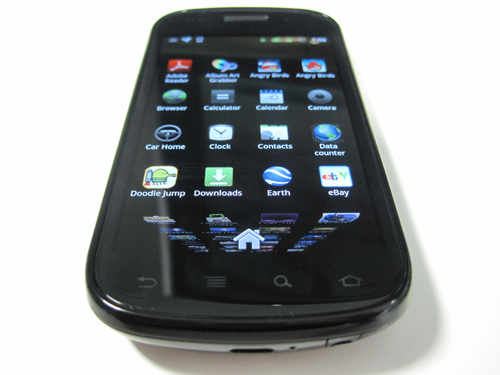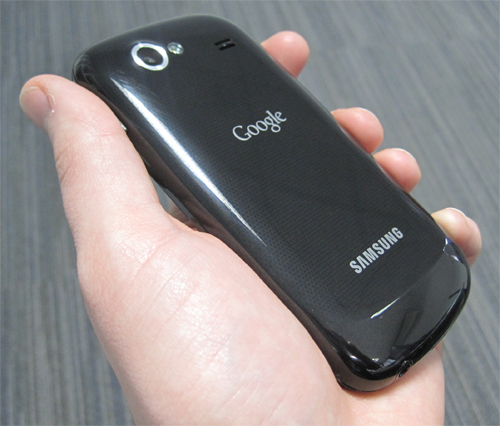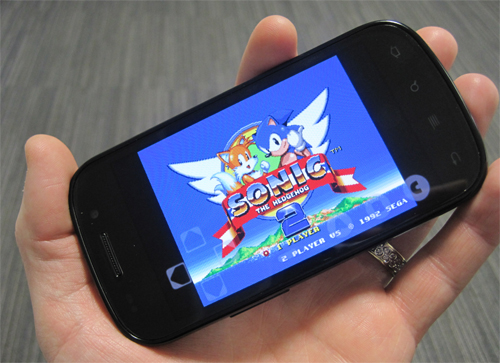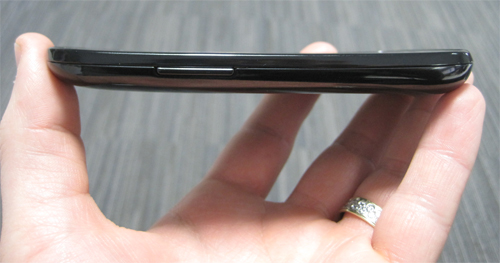
It’s the phone that should never have happened. Following Google’s critically acclaimed but commercially stillborn Nexus One, CEO Eric Schmidt sheepishly proclaimed that there would be no sequel.
Yet a few short months later the first tantalising glimpses of an all-new Nexus device began to appear, proving that Google hasn’t quite given up on the idea of creating its own ‘pure’ mobile experience just yet - and for that we should be extremely thankful.
And the word ‘pure’ summarises the Nexus S quite aptly. Not just in physical terms, but in regards to what’s running under the bonnet: like its forerunner, the Nexus S is rocking an entirely unmolested version of the Android operating system.
In this case, it’s the freshly-baked Gingerbread – otherwise known as Android 2.3 – and this phone is the first (and currently only) place to get it.
 Hold your body close to mine
Hold your body close to mine
But let’s get back to the more immediate allure of this headline device – looks. By shifting allegiance from former ally HTC (the firm responsible for the groundbreaking T-Mobile G1 and the aforementioned Nexus One) to Samsung, Google has ensured that this new product boasts a very different – but no less pleasing - aesthetic appeal.
Samsung’s affection for glossy plastic replaces HTC’s reliance on metal, and the overwhelming use of black gives the device a solid, imposing look. Elsewhere, unusual features abound: the much-hyped ‘contour’ curved display is little more than a gimmick, but the unique reverse-chin on the rear of the device improves grip.
It’s also rather unsettling to discover the headphone jack is at the bottom of the phone rather than at the top, although this will seem less outlandish to those of you who own an iPod touch.
 Button-up
Button-up
In terms of physical interface, the Nexus S is minimalist to the extreme. The only ‘buttons’ on the device are the volume rocker and the power key (which also acts as the ‘lock’ and ‘unlock’ button).
The Nexus One’s trackball has been removed, leaving only touch-sensitive controls on the face of the phone (which have once again had their running order inexplicably rearranged).
Its moniker suggests that this device shares a common bond with the Galaxy S, Samsung’s incredibly popular Android challenger from the middle of 2010. Looking at the raw specifications, this certainly seems to be true: the phones have identical 1GHz Hummingbird processors, stunning 4-inch Super-AMOLED screens, and 5-megapixel cameras.
Unfortunately, limitations within the stock Android OS have forced Samsung to remove 720p video recording - although this may be reinstated via a software update.
There’s also no MicroSD card slot, which is sure to displease dedicated Android fans – although before you reach for that pitchfork and burning torch, it should be noted that this move is in line with rivals such as the iPhone and Microsoft’s Windows Phone.
 Memory management
Memory management
The Nexus S comes with 16GB of internal memory, which should be sufficient for most mobile music listeners and photographers. It also boasts increased app storage space: you can now install up to 1GB of application files, compared to the pitifully inadequate 200MB on the Nexus One.
Nevertheless, we can’t understand why users aren’t granted access to the entire 16GB when it comes to app and games. Although some apps offer the ability to dump a portion of their data into storage (in essence treating it as an SD card) some information has to remain in the section of the phone’s internal memory devoted to applications, and if you’re a heavy user that gigabyte of space will fill up eventually.
When you consider that the iPhone gladly offers up all of its cavernous storage for any combination of music, videos, games and apps, you can’t help but feel that Android is lagging behind in this area.
 Fresh from the oven
Fresh from the oven
Gingerbread has gotten an incredible amount of attention over the past few months, but when compared to its precursor Froyo (also known as Android 2.2) it’s actually a lot less dramatic an update.
There are mild cosmetic changes to enjoy, but on the whole this new edition of the OS is more concerned with tidying up behind the scenes. It’s noticeably smoother and faster than Froyo, although sadly still as prone to occasional moments of lag and stutter when there’s a lot of activity occurring.
As we’ve already mentioned, this is as pure as you’re going to get when it comes to Google’s mobile OS. For some people, this might seem like a disadvantage – especially when placed alongside HTC’s all-singing, all-dancing ‘Sense’ user interface – but hardcore Android fans will be pleased as punch with the absence of ‘bloat-ware’ apps that eat up valuable processor time and can’t be uninstalled.
In fact, this is one of the most streamlined versions of Android yet. Froyo had Twitter and Facebook clients baked-in, but that isn’t the case here. Those of you who already use third-party social aggregators like TweetDeck will be pleased to learn that with Gingerbread, Twitter and Facebook aren’t compulsory installs, and this means you avoid doubling-up on functionality.
 Communication commotion
Communication commotion
Aside from being the first phone to enjoy the delights of Gingerbread, Near Field Communication is the Nexus S’s other big selling point. Using this new feature, you can swipe your mobile device over NFC ‘hotspots’ and get instant access to websites, directions, or YouTube videos.
We dare say that such technology is going to be massive some day, but at the moment there are precious few examples of it here in the UK.
The Samsung Galaxy S has already proven to be a real hit with mobile gamers and unsurprisingly the Nexus S follows suit. That gorgeous Super-AMOLED screen makes games jump to life, and its impressive 4-inch girth gives ample room for finger play.
The powerful Hummingbird CPU grants smooth gameplay, and also allows the hordes of cool Android retro-emulators run quickly and efficiently.
Those of you who have suffered the multi-touch problems that marred the performance of the Nexus One will be pleased to learn that this sequel can accurately track several different points of contact, with none of the bothersome ‘axis-flipping’ that made gaming such a pain on Google’s previous handset.
 The best there is, but for how long?
The best there is, but for how long?
It’s almost impossible to come away from using the Nexus S without feeling suitably impressed. For once, Android has the perfect fusion of technology, software and design. Aside from a few very minor niggles, this really does feel like the real deal.
It’s also worth noting that, like its predecessor, this phone is going to be the recipient of all of the latest Android software updates – possibly months before rival handsets like the HTC Desire HD and even the Galaxy S receive them – making it the only choice for true Android connoisseurs.
However, it would be foolish to ignore the fact that in terms of raw tech the Nexus S could have been far superior. Dual-core CPUs are going to be massive in 2011, and with LG already prepping a phone with this type of processor, the Nexus S might end up being overtaken before it’s had ample opportunity to impress the masses.
For now, though, this is unquestionably the best Android-packing phone available on the market, and despite the lack of cutting-edge internals the guarantee of timely OS updates should be enough to entice steadfast Google fans to make the upgrade.
Google Nexus S

